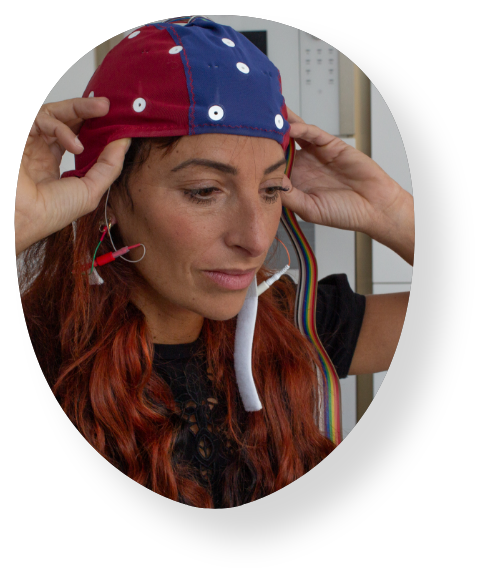Neurofeedback At Home – Your Remote Neurofeedback Solution
At Brainworks, neurofeedback at home isn’t just a service – it’s our specialty. In 2013, we launched the world’s first remote neurofeedback service. This groundbreaking step has since been refined and perfected through continuous development of our bespoke remote training software.
Our home clinic has flourished and all of our training sessions are now performed remotely. This approach offers our clients the convenience and privacy of staying in their own home, cuts out the stress of travelling and makes sessions accessible for everyone.

We ensure that our at-home neurofeedback matches the quality and service level of in-clinic sessions. We use the same advanced equipment that we use in our clinic.
All you need to do is link our computer to your wi-fi, which enables your lead therapist to log on, take over the computer controls and directly communicate to you via the camera. You can see us, we can see you, it’s like having a therapist in your living room. We are expert at guiding you through the process – no technical knowledge is needed.
Once the feedback session has started all you have to do is sit back and enjoy.
Intensive and regular sessions have proven to yield the best results, and our remote setup facilitates this with ease, offering sessions up to six days a week, Monday to Saturday.
Cost-Effective Training
By using 19 channel deep brain technology we are able to provide precise targeted training. There is no guess work or pre-made protocols. The QEEG map enables us to create personalised programs based on your brain, not on your symptoms.
Our services are competitively priced, aiming to make brain training accessible to as many as possible. With the ease of setup and zero travel costs, our at-home neurofeedback therapy is not only convenient but more effective, as we are able to do more sessions in a week.
All in all this is more efficient; enabling goals to be met in faster timeframes than older 2-channel systems.
At Brainworks, neurofeedback at home isn’t just a service – it’s our specialty. In 2013, we launched the world’s first remote neurofeedback service. This groundbreaking step has since been refined and perfected through continuous development of our bespoke remote training software.
Our home clinic has flourished and all of our training sessions are now performed remotely. This approach offers our clients the convenience and privacy of staying in their own home, cuts out the stress of travelling and makes sessions accessible for everyone.
Quality and Service at Your Convenience
We ensure that our at-home neurofeedback matches the quality and service level of in-clinic sessions. We use the same advanced equipment that we use in our clinic.
All you need to do is link our computer to your wi-fi, which enables your lead therapist to log on, take over the computer controls and directly communicate to you via the camera. You can see us, we can see you, it’s like having a therapist in your living room. We are expert at guiding you through the process – no technical knowledge is needed.
Once the feedback session has started all you have to do is sit back and enjoy.
Intensive and regular sessions have proven to yield the best results, and our remote setup facilitates this with ease, offering sessions up to six days a week, Monday to Saturday.
Cost-Effective Training
By using 19 channel deep brain technology we are able to provide precise targeted training. There is no guess work or pre-made protocols. The QEEG map enables us to create personalised programs based on your brain, not on your symptoms.
Our services are competitively priced, aiming to make brain training accessible to as many as possible. With the ease of setup and zero travel costs, our at-home neurofeedback is not only convenient but more effective, as we are able to do more sessions in a week.
All in all this is more efficient; enabling goals to be met in faster timeframes than older 2-channel systems.
Our at-home training is designed to achieve the mental and emotional outcomes you’re seeking. Starting with a discussion about your goals, we tailor your program for maximum impact. Advanced qQEEG brain mapping pinpoints the brain activity linked to your concerns, setting the stage for effective training.
With frequent sessions, we build upon the data to address the root of your symptoms, ensuring that the neurofeedback training effectively meets your needs.
Getting Started with At-Home Neurofeedback
1.
Free Consultation:
Contact us to arrange a free consultation to discuss your symptoms, and goals and fill in our online in take form, to see if at-home neurofeedback is right for you.
Free Consultation
2.
Assessment:
Book an in-person qEEG map and assessment in our London Clinic or arrange for the assessment to be conducted with our at home remote service.
Assessment

3.
Equipment:
Receive a complete neurofeedback training station with our proprietary Brainworks software.
Equipment
4.
Sessions:
We connect remotely to run your sessions, with regular qQEEG brain maps to track your progress.
Sessions
5.
Completion:
Once your training concludes, your lead therapist will review your journey before we retrieve the equipment, leaving you with the lasting benefits of your personalised neurofeedback journey.
Completion






